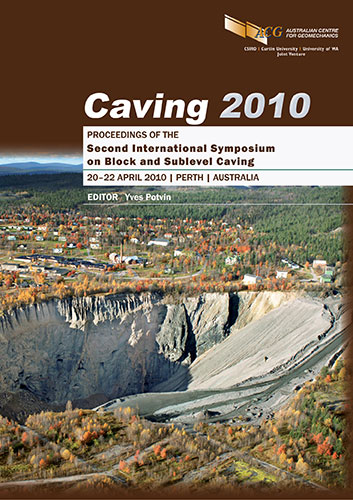Strategic considerations in block caving

|
Authors: Butcher, RJ; Smith, G |
DOI https://doi.org/10.36487/ACG_rep/1002_14_Butcher
Cite As:
Butcher, RJ & Smith, G 2010, 'Strategic considerations in block caving', in Y Potvin (ed.), Caving 2010: Proceedings of the Second International Symposium on Block and Sublevel Caving, Australian Centre for Geomechanics, Perth, pp. 231-236, https://doi.org/10.36487/ACG_rep/1002_14_Butcher
Abstract:
Over the last 20 years there have been considerable advances in geotechnical techniques used in the design of block caves. However, despite these advances the successful development of a block caving project relies heavily on many non geotechnical factors such as commodity price, exchange rate and development exploration timing. An understanding of the impacts of these factors is important as they can have a material impact on size, depth and method of undercutting a block cave. This paper further discusses the impacts of fluctuations in commodity prices on cave design by the use of a conceptual model, developing guidance in terms of potential mitigation strategies and options to be employed.
References:
Areneda, O. and Sougarret, A. (2007) Keynote Address: Lessons learned in cave mining: El Teniente 1997–2007, in Proceedings First International Symposium on Block and Sub-level Caving, Southern African Institute of Mining and Metallurgy, Johannesburg, South Africa, pp. 59–72.
Bartlett, P.J. and Croll, A. (2000) Cave mining at Premier Diamond Mine, in Proceedings MassMin 2000, Australasian Institute of Mining and Metallurgy, Melbourne, Victoria, pp. 227–235.
Beck, D., Arndt, S., Thin, I., Stone, C. and Butcher, R. (2006) A conceptual sequence for a block cave in an extreme stress and deformation environment, in Proceedings Deep and High Stress Mining, Australian Centre for Geomechanics, Perth, Australia, pp. 65–76.
Butcher, R.J. (1999) Design rules for avoiding draw horizon damage in deep level block caves, Southern African Institute of Mining and Metallurgy, Johannesburg, South Africa, Vol. 00, No. 2, pp. 151–155.
Butcher, R.J. (2000) Block cave undercutting – aims, strategies and methods and management, in Proceedings MassMin 2000, Australasian Institute of Mining and Metallurgy, Melbourne, Australia, pp. 113–119.
Butcher, R.J. (2003) Cave Mining Geomechanics, course notes, Australian Centre for Geomechanics, Perth, Australia.
Butcher, R.J. (2004) DEESA – An approach to determine if an orebody will cave, in Proceedings MassMin 2004, Santiago, Chile, pp. 49–54.
Butcher, R.J. and Thin, I.G.T. (2007) The inputs and choices for predicting fragmentation in block cave projects, in Proceedings First International Symposium on Block and Sub-level Caving, Southern African Institute of Mining and Metallurgy, Johannesburg, South Africa, pp. 35–49.
Flores, G. and Karzulovic, A. (2004) Current practices and trends in cave mining, in Proceedings MassMin 2004, Santiago, Chile, pp. 83–90.
Pretorius, D. (2007) The effect of dilution on the underground block cave ore reserves at Palabora Mining Company, in Proceedings First International Symposium on Block and Sub-level Caving, Southern African Institute of Mining and Metallurgy, Johannesburg, South Africa, pp. 73–81.
© Copyright 2025, Australian Centre for Geomechanics (ACG), The University of Western Australia. All rights reserved.
View copyright/legal information
Please direct any queries or error reports to repository-acg@uwa.edu.au
View copyright/legal information
Please direct any queries or error reports to repository-acg@uwa.edu.au